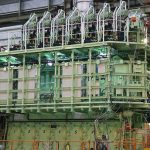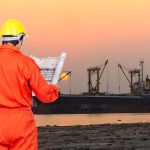In today’s world, the four main materials used for building boats, when we talk at the level of mass manufacturers, are steel, aluminium, fibre-reinforced plastic (FRP), and polyethylene. Let us speak about each of these in greater detail.
Steel
Steel is one of the most popular materials used for boats and has consistently been the material of choice for the past century. Its high strength, durability, resistance to abrasion, and relatively low cost are some of the main reasons why steel is widely used in the industry. However, in the wake of the development of new composite materials, better and cheaper alternatives are being used for manufacturing boats of equal size and strength but considerably lesser weight. This has reduced the importance of steel in boat building to an extent, although it is still used extensively for larger ships.
From the point of view of sustainability, steel has a practically airtight production process that produces minimal constructional waste. In addition, it is completely recyclable at the end of its life cycle and hence is a sustainable material for boats.
Aluminium
Aluminium is preferred by a lot of boat manufacturers on account of its being lightweight, especially when compared to steel. Aluminium boats are more stable and seaworthy and can travel faster due to reduced weight. This means that you get better mileage for the same quantity of fuel from an aluminium boat. Easy workability and its properties like chemical and corrosion resistance, imperviousness to magnetism, and tendency for plastic deformation make aluminium a strong option for boat building.
On the downside, aluminium is expensive. Also, aluminium is a soft metal and hence more susceptible to abrasion. Coming to sustainability, aluminium is recyclable, so that is a point in its favour. Application of eco-friendly paint instead of lead-based paint can be a helpful addition to making an aluminium boat more sustainable.
Fibre-reinforced plastic (FRP)
Fibre-Reinforced Plastic has come to heavily dominate the boat material sector over the past few decades, primarily because it is one of the best options available in the market. A single structure that is light, speedy, strong, watertight, durable, and corrosion-free makes for a great solution. Although initially adopted for military use, FRP has permeated all the levels of maritime applications and is increasingly used as a substitute for wood and steel today.
Economical viability is not one of FRP boats strengths, because though the material required for manufacturing these boats is moderately cheap, the process itself requires skilled labour and a knowledge of boat making principles. However, when you consider the return on investment, FRP boats have a much better ROI on account of their longer life and are hence by far the best building material for boats.
When it comes to sustainability, FRP composites are completely recyclable and have no adverse effects on the marine ecosystem. As a matter of fact, according to this statistic by Boat Digest, 95% of 7 million pleasure boats were built from fibre-reinforced plastic. This high rate of adoption can be attributed to the durability and marine-friendliness of the FRP composite material. Several renowned boat manufacturers in India incorporate FRP into boat manufacturing across all marine verticals.
Polyethylene
Polyethylene is an extremely versatile material that serves boat building well across all marine applications like surveillance, amateur and professional fishing, security, etc. The principal quality of high-density polyethylene is that it has a high strength-to-density ratio. Advanced chemical and impact resistance, low maintenance, and greater buoyancy also make it highly suitable for boat construction. Aesthetically, polyethylene boats are moulded (like FRP) as opposed to fabricated (like aluminium). This implies that complex designs are possible, though tolerances for moulding parts are smaller than those for fitting. The processes used to manufacture polyethylene boats include rotational moulding and thermoforming.
There are some minor disadvantages of polyethylene boat material as well. First, it is not as structurally stiff as aluminium or fibreglass, which limits the number of boats that can be manufactured. Secondly, polyethylene becomes brittle over time, and cannot withstand high temperature without deforming. The biggest drawback is that bonding agents like epoxy resins, adhesives, and vinyl cement do not adhere to polyethylene boats.
From the sustainability perspective, polyethylene is a good choice as it is recyclable. Fuel consumption is reduced due to the lighter weight and lack of hull paint.
Summing Up
Modern boat and ship design incorporates a variety of hull materials, depending on the size, application, and expected life of the vessel. For smaller, recreational or shallow-sea activities, polyethylene boats are a good choice, both environmentally and economically. FRP boats are preferred for activities like coastal patrol, rescue and security operations, and fishing. Wood, steel, and aluminium remain continuing favourites for larger ships transporting cargo.
The choice of material directly impacts the performance and efficiency of the boat, and hence, the environment. It is important that all these factors for improving sustainability be taken into consideration by boat designers and manufacturers to select the best possible alternative for building the boat.


